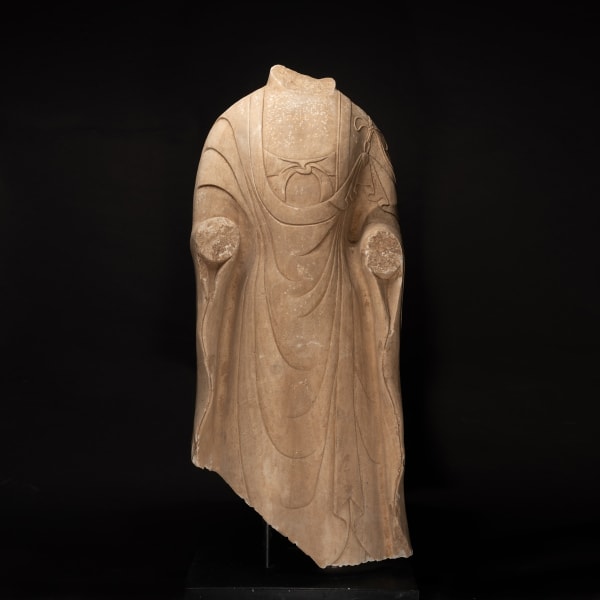-

-
Timeline
1961 – 1967: Fayez employed by Kathleen Kenyon in excavating Jerusalem. During the last few years becomes her most trusted assistant.
1963-70: Fayez assists Professor Nelson Gleck, Professor William Dealer, and Gerald A. Larue in both excavation and research. His most notable scholarly collaborations from this period were with Pierre Deveaux and Father Spiekermann.
1963/4: Fayez is introduced to preeminent Egyptian jeweller and antiquarian Emil Saad, who helped him acquire first masterpiece neither excavated or inherited in Palestine of a Nefertem sculpture from the Omar Sultan collection. This item since became the gallery’s insignia and the gallery’s original concept was based on the symbolism of the deity’s openness to the world and culture as ‘the mirror of all ages and cultures’.1967: First major gallery opened in Jerusalem’s Old City in partnership with family. Establishes first non-touristic antiquities collection recognised by the Israeli ministry of culture and tourism.
1967: Curates Moshe Dayan’s private art collection.
1969-71: Fayez initiates curatorial collaboration with Jiri Frel who introduces him to J.P. Getty. Fayez acquires numerous pieces for the Getty collection.
1970 – 1982: Independently opens largest gallery of museum quality Near Eastern, Classical and Egyptian antiquities in Bethlehem.
1970-83: Fayez acquires inventory for billionaire Bob Cummings, as well as previous owner of Sotheby’s Alfred Taubman.
1983: Metropolitan Museum endorses Fayez’s application for US citizenship, and the Getty, Tom Bradley and Fred Croton advocated for the opening of Barakat Gallery in Los Angeles.
1993: Fayez sells original container of the Dead Sea Scrolls to the Martin Schoyen.2003: Barakat London opens.
2007-2015: Abu Dhabi Gallery. Brought commercial non-Islamic antiquities for the first time to the UAE.
2016: Opening of Barakat Seoul.
2017: Opening of Hong Kong branch and relocation of Barakat Gallery in Beverly Hills to LCDQ. -
Exerpt from “A Preface for The Collection”
By Gerald A. LarueAs a young boy Fayez worked beside the famous British archaeologist, Dr. Kathleen Kenyon, sorting and identifying shards from her excavation in the ancient Jerusalem of King David’s time. Fayez became familiar with pottery classifications and with the basic principles of field archaeology.
His facility in learning languages was startling. With his photographic memory he could quickly master a new language, including vocabulary and grammar, and conduct intelligent conversations with visitors from different countries in Europe in their native languages.
At the age of fourteen, when he was deeply engrossed in reading medical textbooks in preparation for his intended career in medicine, he met Father James McGuire of Loyola University. The reverend father, as a good teacher, put Fayez to the test. He thumbed through the texts and asked questions of the young man. So impressed was he by Fayez’s answer that he offered him a Fullbright scholarship. When the papers arrived in Jerusalem, Fayez’s father distressed at the thought of being separated from his son, quietly secreted the documents until the time for accepting the invitation had elapsed.
During 1967 artifacts from plundered tombs in the hill country west of Hebron began to stream into Jerusalem. Fayez, like other merchants, made purchases from the villagers. He acquired numerous common household objects from periods extending from Middle Bronze I (2100-1900 B.C. ) through the Byzantine era (A.D. sixth century). Soon he began to accept only those choice items that represented the finest statements of the ancient craftsman’s art.
About this same time, Dr. Nelson Glueck, president of Hebrew Union College, a world-renowned scholar and archaeologist, invited Fayez to attend classes in the Jerusalem school. Soon he was enrolled in courses taught by the eminent Middle Eastern archaeologist, Dr. William Denver. Under the guidance of Father Spiekerman, director of the Museum of the Flagellation at the Second Station of the cross in Jerusalem, he researched ancient coinage. He read and studied archaeological journals, excavation reports, and the best sources in art history. Consequently, he has become one of those unique individuals whose knowledge combines the results of classroom studies, extensive reading and research, and practical field experience with intimate familiarity with artifacts developed through handling thousands of items.
Today, Fayez is more than a merchant; he is a connoisseur devoted to a dream. He believes he owes something to the archaeologists and instructors who helped develop his expertise-and indeed, to all who probe the past and help us appreciate our rich human heritage. He has undertaken a duty to preserve the past and to save from possible damage and loss these exquisite artistic statements. He has witnessed the destruction of precious ancient objects by simple villagers who feared fines for possession of such items or perhaps confiscation by the government of the land on which they were found. Once an artifact is destroyed, whatever it might tell us of the past is beyond recovery and its usefulness as a clue to the understanding the creative spirit is forever lost.
-
More
-

Who Am I?
September 1, 2016 -

Profile: Fayez Barakat, Barakat Gallery Korea
September 1, 2016 -

5 minutes with Fayez Barakat
October 1, 2016 -

Not Just Any Old Stuff! - An Interview With Fayez Barakat
April 1, 2003 -

Fayez Barakat: 'Something powerful is overflowing'
November 19, 2010A hard-nosed entrepreneur with a talent for spotting priceless artefacts, Fayez Barakat has become an artist whose paintings have been described as 'more powerful and explosive in mood than most... -

Enlightenment and Transcendence
Seoul 21 November 2018 - 7 April 2019Barakat Seoul presents the exhibition Enlightenment and Transcendence from Wednesday, November 21, 2018 to Sunday, March 31, 2019. The Sanskrit word ksana is used to refer to the smallest possible...
-






